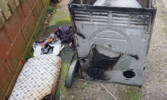- Joined
- 27 Jan 2008
- Messages
- 25,298
- Reaction score
- 2,957
- Location
- Llanfair Caereinion, Nr Welshpool
- Country

I am sure all are dangers, fluff built up, poor connections on plug or socket, and contaminated clothes, as to how anyone works out which was the cause when they see thisI was intending to correct the statement that fires were not caused by fluff, nor overloaded sockets. This would seem to be a message having a negative effect.
The picture further down the report
 clearly shows a vented drier. A Google for "heat pump tumble dryer fire risk" shows the same results as "tumble dryer fire risk" in the main, I did find one report however don't recognise the organisation so it could simply be an advert.
clearly shows a vented drier. A Google for "heat pump tumble dryer fire risk" shows the same results as "tumble dryer fire risk" in the main, I did find one report however don't recognise the organisation so it could simply be an advert.We have to consider how the drier works, it passes air through the clothes which is drier than the clothes in the drum, it is made drier either by using a fresh supply all the time, or extracting the moisture from recirculated air, the way if extracts the moisture is to cool the air, the cooler the air, the more moisture extracted, so we have cooled by air in the room, cooled by cold water, and cooled with a heat pump, the heat pump in general can cool the air to a lower temperature to using cold water or ambient air, so it does not need to heat the air as much to extract moisture from the cloths.
In general, it runs around 20ºC cooler than the air or water cooled, and it also controls the temperture, the early vented tumble triers had no temperture control, except for a over temp cut out. Where with the heat pump drier, the energy monitor shows it starts to do a mark/space ratio if the air gets too hot.
I fail to see how we can compare the modern heat pump drier with the old vented type, they are so diffrent, there was at one point a vented drier designed to work over night, is had some thing like a 500 watt heater instead of 2000 watt, and was designed to take around 3 hours, using off peak supplies.
I note my heat pump tumble drier if set for delayed start, tumbles the clothes every so often while waiting for start time, same with washing machine, it does seem wrong way around to me, more important to tumble every so often once finished.
